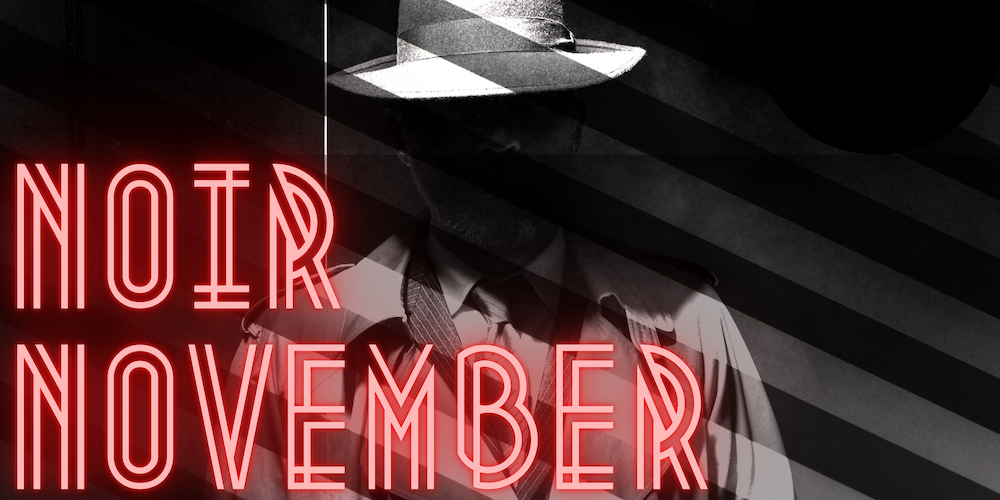Noir November: Strangers on a Train
Written by Cameron Geiser
Every day for the month of November, Cameron Geiser is reviewing a noir film (classic or neo) for Noir November. Today covers another Hitchockian caper: Strangers on a Train.
Have you ever been in a crowded train, bus, or subway and locked eyes with a stranger? Imagine this chance encounter with a total stranger turning into an agreement where each of you kills the other’s worst enemy. This criss-cross murder deal is the set-up and hook of this Alfred Hitchcock film, but what really makes the thriller take off is that the “perfect crime” only works if both parties agree to the murder pact. What happens when one corpse turns up, but the other mark remains in the realm of the living? Suspense, that’s what.
Strangers on a Train has a concept seemingly made just for Alfred Hitchcock to adapt. No one does “innocent man framed for murder” better than Hitchcock after all. He fully utilizes the storytelling tools of coincidence and commonplace incidents to ratchet up the tension as the film rolls merrily along it’s murderous path. The film begins with two opposing shots of shoes walking through a train station. One set is a pair of fancy white and black dress shoes with a quickened pace about them while the other is a pair of brown casual business wear set to a more relaxed speed. This alone should already key in audiences to the breadth of distance between the two characters. Once on the train Guy Haines (Farley Granger) takes the empty seat in the dining car for lunch when he’s met by Bruno Antony (Robert Walker) smirking across the way. Bruno casually admits to knowing the particulars of Guy’s public life as a famous Tennis player. Guy’s in a loveless marriage and the rumor mill suggests he’s trying to get divorced so he can marry the daughter of a Senator. Initially perturbed a bit by Bruno’s intensity and intimate knowledge of his life, Guy casually handwaves any awkwardness away and tries to keep everything kosher.
Farley Granger and Robert Walker, the titular Strangers on a Train.
Moving past the small talk, it isn’t long before Bruno divulges an idea of his, for the perfect murder. After Guy hears Bruno’s plan, he feigns amusement for the sake of politeness, but Bruno believes this to be an endorsement of his plan. You see, Bruno’s rich father thinks quite lowly of him. He doesn't approve of Bruno's playboy ways and he's not exactly ready to hand over the family's finances just yet. Thus by Bruno's logic, he must die. After they depart the train Bruno completes his end of the deal by strangling Guy's promiscuous wife, Miriam (Kasey Rogers), that night at a carnival while Guy heads back home after having an argument with her about the divorce. The next day Guy is given the news of Miriam's death while visiting Anne (Ruth Roman), the Senator’s daughter.
Bruno confronts Guy right away and a lot of the second half of the film follows that tension. Bruno coyly following Guy and Anne around, integrating himself into their social lives, constantly trying to get Guy to deliver on the pact and murder his father. At one point Bruno sends Guy a gun with a hand drawn map of his house pointing to where his father sleeps. Guy decides to confront the situation and he goes to the house with the intention of waking Bruno's father and explaining his son's crazy ordeal. However, he finds Bruno there in his fathers place which did make me laugh out loud in the moment. The finale crescendos into Guy chasing Bruno down at the carnival where Bruno intended to plant evidence incriminating Guy for Miriam's murder. However things got a little complicated on the merry-go-round when the intervening police accidentally shot the operator sending the ride careening into a blistering speed. It's quite the thrilling end in which Bruno is crushed to death by the ride when it's abruptly stopped by another carnival operator belly crawling underneath it to hit the emergency break.
Many count this film as the beginning of Hitchcock's renaissance in directing, the 1950's would be his best working decade after all, and I'd have to agree. What Hitchcock brought to the film was his tight control over the technical camera shots and his precision in directing actors with memorable scenes. The Tennis match that Guy has to play before racing off for the final confrontation with Bruno comes to mind. The crowd watching the game is full of heads turning to each side of the court. Dozens of heads were tilting left to right and following the match, except for one face, Bruno's. In fact, the role of Bruno as played by Robert Walker makes the entire film rise above the premise alone.
His performance constantly reminded me of John de Lancie's frequent portrayal of the character called “Q” on Star Trek: The Next Generation. I tried to find out if John de Lancie was intentionally pulling from Walker's performance in this film, but to no avail. Both roles embrace charming, dangerous, and playful characters who were always capable of malice at any given moment. Though Granger's role as Guy Haines helped balance the movie in subtle ways as well. Hitchcock initially wanted William Holden for the role of Guy Haines, at least that’s what he told Francois Truffaut. But while Holden was perfect for a similar role as Sunset Boulevard’s Joe Gillis, Farley Granger brought an altogether different physicality and authenticity to his character’s requirements in this story. I'm not sure if Holden would have been as believably under-the-thumb of Bruno as Granger was. The film works at its best when Walker and Granger are on screen together, paired with Hitchcock's mastery of eliciting exquisite paranoia in his thrillers, this Noir is certainly worth the watch!
Cameron Geiser is an avid consumer of films and books about filmmakers. He'll watch any film at least once, and can usually be spotted at the annual Traverse City Film Festival in Northern Michigan. He also writes about film over at www.spacecortezwrites.com.






